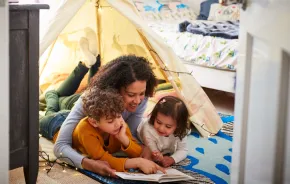
When Kirsten Langdon’s children pointed out a shell’s Fibonacci pattern while beachcombing, she was a bit surprised. The homeschooling mom planned to teach her children about the numerical patterns found in nature. However, as of that moment, she had yet to broach the topic.
As it turned out, her children had stumbled on that fascinating fact all on their own. Langdon credits their online learning tool: Khan Academy.
Rather than hovering over her children’s shoulders as they do their online assignments, Langdon, who lives in Duvall, feels safe allowing her children to navigate through Khan’s many educational topics.
“I like it because they are on the computer and they can talk and be kids, but it is [safe],” explains Langdon, whose children are 16, 13 and 12. “I don’t have be constantly watching them. I know they are safe on the Internet. They are not just floating free.”
Langdon discovered Khan Academy three years ago while looking for a more efficient way to teach math to her kids.
“I can teach history as a group, but with math, they are all on a different level,” she says. “It can be very time consuming.”
While it was math that prompted her to seek out online learning tools in the first place, Langdon is pleased with the variety of topics her children can explore. Her 16-year-old daughter is learning computer coding through Khan, a topic to which she would not otherwise be exposed.
“I know nothing about computer coding,” Langdon admits.
While online learning tools are an obvious option for homeschooling families, there are plenty of parents and educators who are also supplementing traditional education with online learning services.
Sheryl Carlson, a Gig Harbor–based mom, used HomeschoolMath worksheets at home to supplement her children’s elementary education.
“This has been especially helpful in keeping my kids’ minds extra active with math over summer,” she says. “They were able to jump back in to school without being rusty.”
The term for this is “blended education,” which means students are still taking part in traditional education, whether at school or home, but also using online learning tools.
Learning as fun
Online learning options can be intuitive and can deliver a customized education experience.
DreamBox Learning, a Bellevue-based online learning service, collects 50,000 data points per student per hour. For example, the program monitors how long a student takes to do a lesson and how many times he or she needs to go through it. Once it’s clear the lesson has been mastered, the program moves the student to the next lesson.
“Half the battle with math is getting [students] excited about doing it and achieving success,” says Dawn Moye, blended learning manager at Federal Way Public Schools. “This is the first time we’re seeing students gain self-esteem because of their math success. Kids think it’s fun, and teachers are using the powerful data in DreamBox to modify what they’re doing in the classroom.”
DreamBox is used by students in all 50 states, Washington, D.C., and Canada. Locally, customers include Bellevue, Renton, Federal Way and Tahoma school districts. Seattle schoolteachers have used it as well.

Do the math
The number of students using online learning tools continues to grow.
IXL, a tool that serves both schools and families, reports it has grown to 5 million subscribers in 190 countries since starting seven years ago. The company says that one in 10 students in the United States uses IXL.
DreamBox has 1.5 million active users and expects to teach 1 million math lessons per day this year. Khan Academy has 15 million registered students, 12 million of whom use the site each month.
Isaac Durand, a communications associate at Khan Academy, points out that all of the lessons can be accessed without registration.
Khan Academy started in 2003 when founder Salman Khan began tutoring his cousin, Nadia, in math. Soon, other family members were looking for help. To accommodate the growing number of requests, Khan began posting his tutorials on YouTube. He soon realized that his relatives weren’t the only people looking for assistance with learning.
Khan saw a strong demand for this type of tutoring from people all over the world. He didn’t want to limit access for those who couldn’t pay.
“Khan made the program free because it is exciting to him to be able to impact those people who are underserved,” Durand says. “He doesn’t want to deny students who are unable to pay.”
While free, Khan Academy does accept donations. DreamBox does charge for its service, but costs are low enough that school districts and many parents can afford it. School districts pay $7,000 a year. Smaller districts are charged $25 per student. Parents can purchase a similar package starting at $59.95 per six months per student.
“At this moment in history, we have a terrific opportunity to democratize learning opportunities by leveraging a new class of technologies that can impact learning dynamically and continuously,” says Jessie Woolley-Wilson, CEO and president of DreamBox Learning. “Through the effective use of personalized learning technologies, we can unlock the learning potential of every child, regardless of what ZIP code they are from.”
Reshaping opportunity
As the popularity of blended learning and other tech-inclusive classroom environments grows, more online tools will be created, says Jennifer Gu, executive vice president of IXL.
“There are no boundaries online as with traditional textbooks and worksheets,” Gu says. “At IXL, for example, we computer-generate our questions so that students rarely see the same question twice and can practice as long as they need to master a skill.”
Single- and multi-district blended and online programs are the largest and fastest growing segment of online and blended learning, according to the International Association for K–12 Online Learning. Schools are making online learning opportunities available to their students as a way to offer courses not available in the schools, particularly in urban districts.
For Langdon, the value of online learning tools is the opportunity for her children to learn what they want, when they want.
“If they are ready for something, they will embrace it,” Langdon says. “Even if they don’t immediately understand, there is still a shadow of knowledge there and when it comes up again, they will better understand it.”











